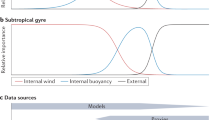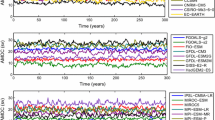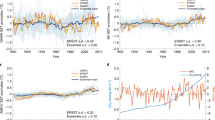Abstract
There is a controversy about the origin of the recent decadal Atlantic Meridional Overturning Circulation (AMOC) slowing observed at 26.5°N and concurrent sea surface temperature cooling in the central and eastern mid-latitude North Atlantic. We investigate decadal AMOC slowing events simulated in a multi-millennial preindustrial control integration of the Kiel Climate Model (KCM), providing an estimate of internal AMOC variability. Preindustrial control integrations of 15 models participating in the Coupled Model Intercomparison Project phase 5 also are investigated, as well as historical simulations with them providing estimates of AMOC variability during 1856–2005. It is shown that the recent decadal AMOC decline is still within the range of the models’ internal AMOC variability and thus could be of natural origin. In this case, the decline would represent an extreme realization of internal variability provided the climate models yield realistic levels of AMOC variability. The model results suggest that internal decadal AMOC variability is large, requiring multi-decadal observational records to detect an anthropogenic AMOC signal with high confidence. When analyzing the strongest decadal AMOC slowing events in the KCM, which have amplitudes similar to or larger than the recently observed decadal AMOC decline, the following composite picture emerges: a very strong decadal AMOC decline is preceded by a decadal rise in atmospheric surface pressure over large parts of the mid-latitude North Atlantic. The change in low-level atmospheric circulation drives reduced oceanic heat loss over and diminished upper-ocean salt content in the Labrador Sea. In response, oceanic deep convection and subsequently the AMOC and northward oceanic heat transport weaken, and anomalously cold sea surface temperatures develop in the central and eastern mid-latitude North Atlantic.











Similar content being viewed by others
References
Barnston AG, Livezey RE (1987) Classification, seasonality and persistence of low-frequency atmospheric circulation patterns. Mon Weather Rev 115:1083–1126
Bindoff NL et al (2013) Climate change 2013. In: Stocker TF et al (eds) The physical science basis. Cambridge University Press, Cambridge, pp 867–952
Booth BB, Dunstone NJ, Halloran PR, Andrews T, Bellouin N (2012) Aerosols implicated as a prime driver of twentieth-century North Atlantic climate variability. Nature 484:228–232
Bryden HL, King BA, McCarthy GD, McDonagh EL (2014) Impact of a 30% reduction in Atlantic meridional overturning during 2009–2010. Ocean Sci 10:683–691
Caesar L, Rahmstorf S, Robinson A, Feulner G, Saba V (2018) Observed fingerprint of a weakening Atlantic Ocean overturning circulation. Nature 556:191–196
Cheng W, Chiang JCH, Zhang D (2013) Atlantic meridional overturning circulation (AMOC) in CMIP5 models: RCP and historical simulations. J Clim 26:7187–7197
Cheung AH et al (2017) Comparison of low-frequency internal climate variability in CMIP5 models and observations. J Clim 30:4763–4776
Cunningham SA et al (2013) Atlantic Meridional Overturning Circulation slowdown cooled the subtropical ocean. Geophys Res Lett 40:6202–6207
Delworth TL, Zeng F (2012) Multicentennial variability of the Atlantic meridional overturning circulation and its climatic influence in a 4000 year simulation of the GFDL CM2.1 climate model. Geophys Res Lett 39:L13702. https://doi.org/10.1029/2012gl052107
Delworth TD, Manabe S, Stouffer RJ (1993) Interdecadal variations of the thermohaline circulation in a coupled ocean–atmosphere model. J Clim 6:1993–2011
Dima M, Lohmann G (2010) Evidence for two distinct modes of large-scale ocean circulation changes over the last century. J Clim 23:5–16
Drijfhout S, van Oldenborgh GJ, Cimatoribus A (2012) Is a decline of AMOC causing the warming hole above the North Atlantic in observed and modeled warming patterns? J Clim 25:8373–8379
Goddard PB, Yin J, Griffies SM, Zhang S (2015) An extreme event of sea-level rise along the Northeast coast of North America in 2009–2010. Nat Commun 6:6346
Handmann P et al (2018) The deep western boundary current in the labrador sea from observations and a high-resolution model. J Geophys Res Oceans 123:2829–2850. https://doi.org/10.1002/2017JC013702
Hurrell JW (1995) Decadal trends in the North Atlantic Oscillation: regional temperatures and precipitation. Science 269:676–679
Iwi AM, Hermanson L, Haines K, Sutton RT (2012) Mechanisms linking volcanic aerosols to the Atlantic meridional overturning circulation. J Clim 25:3039–3051
Jackson LC, Peterson KA, Roberts CD, Wood RA (2016) Recent slowing of Atlantic Overturning Circulation as a recovery from earlier strengthening. Nat Geosci 9:518–522
Jung T, Vitart F, Ferranti L, Morcrette JJ (2011) Origin and predictability of the extreme negative NAO winter of 2009/10. Geophys Res Lett 38(7):2. https://doi.org/10.1029/2011gl046786
Levermann A, Griesel A, Hofmann M, Montoya M, Rahmstorf S (2005) Dynamic sea level changes following changes in the thermohaline circulation. Clim Dyn 24:347–354
McCarthy GD et al (2015a) Measuring the Atlantic Meridional overturning circulation at 26°N. Prog Oceanogr 130:91–111
McCarthy GD, Haigh ID, Hirschi JJ-M, Grist JP, Smeed DA (2015b) Ocean impact on decadal Atlantic climate variability revealed by sea-level observations. Nature 521:508–510
Nigam S, Ruiz-Barradas A, Chafik L (2018) Gulf Stream excursions and sectional detachments generate the decadal pulses in the Atlantic multidecadal oscillation. J Clim 31(7):2853–2870
Park W, Latif M (2008) Multidecadal and multicentennial variability of the meridional overturning circulation. Geophys Res Lett 35:L22703. https://doi.org/10.1029/2008gl035779
Park W, Latif M (2012) Atlantic meridional overturning circulation response to idealized external forcing. Clim Dyn 29:1709–1726
Park W, Keenlyside N, Latif M, Ströh A, Redler R, Roeckner E, Madec G (2009) Tropical pacific climate and its response to global warming in the Kiel climate model. J Clim 22(1):71–92. https://doi.org/10.1175/2008jcli2261.1
Park T, Park W, Latif M (2016) Correcting North Atlantic sea surface salinity biases in the Kiel Climate Model: influences on ocean circulation and Atlantic Multidecadal Variability. Clim Dyn 47:2543–2560
Pohlmann H et al (2013) Predictability of the mid-latitude Atlantic meridional overturning circulation in a multi-model system. Clim Dyn 41:775–785
Reintges A, Martin T, Latif M, Keenlyside NS (2017) Uncertainty in twenty-first century projections of the Atlantic Meridional Overturning Circulation in CMIP3 and CMIP5 models. Clim Dyn 49:1495–1511
Ritz SP, Stocker TF, Grimalt JO, Menviel L, Timmermann A (2013) Estimated strength of the Atlantic overturning circulation during the last deglaciation. Nat Geosci 6:208–212
Roberts CD, Jackson L, McNeall D (2014) Is the 2004–2012 reduction of the Atlantic meridional overturning circulation significant? Geophys Res Lett 41:3204–3210
Robson J, Hodson D, Hawkins E, Sutton R (2013) Atlantic overturning in decline? Nat Geosci 7:2–3
Robson J, Ortega P, Sutton R (2016) A reversal of climatic trends in the North Atlantic since 2005. Nat Geosci 9:513–517
Saba VS et al (2016) Enhanced warming of the Northwest Atlantic Ocean under climate change. J Geophys Res Oceans 121:118–132
Schmittner A, Latif M, Schneider B (2005) Model projections of the North Atlantic thermohaline circulation for the 21st century assessed by observations. Geophys Res Lett 32:L23710. https://doi.org/10.1029/2005gl024368
Smeed DA et al (2014) Observed decline of the Atlantic Meridional Overturning Circulation 2004 to 2012. Ocean Sci 10:39
Smeed et al (2018) The North Atlantic Ocean is in a state of reduced overturning. Geophys Res Lett 45:1527–1533
Srokosz MA, Bryden HL (2015) Observing the Atlantic Meridional Overturning Circulation yields a decade of inevitable surprises. Science 348:1255575
Sun B, Yu L, Weller RA (2003) Comparison of surface meteorology and turbulent heat fluxes over the Atlantic NWP model analyses versus moored buoy observations. J Clim 16:679–695
Sutton RT, Hodson DLR (2005) Atlantic ocean forcing of North American and European summer climate. Science 309:115–118
Swingedouw D et al (2015) Bidecadal North Atlantic ocean circulation variability controlled by timing of volcanic eruptions. Nat Commun 6:6545
Taylor KE, Stouffer RJ, Meehl GA (2012) An overview of CMIP5 and the experiment design. Bull Am Meteorol Soc 93:485–498
Yang Q et al (2016) Recent increases in Arctic freshwater flux affects Labrador Sea convection and Atlantic overturning circulation. Nat Commun 7:13545
Yashayaev I, Loder JW (2016) Recurrent replenishment of Labrador Sea Water and associated decadal-scale variability. J Geophys Res Oceans 121:8095–8114
Zhang R et al (2013) Have aerosols caused the observed atlantic multidecadal variability? J Atmos Sci 70(4):1135–1144. https://doi.org/10.1175/jas-d-12-0331.1
Acknowledgements
This study was supported by the BMBF’s project “RACE II” and by the InterDec project “The potential of seasonal-to-decadal-scale inter-regional linkages to advance climate predictions” of the JPI CLIM Belmont-Forum. The climate model integrations were performed at the Computer Centre at the Kiel University and at the High Performance Computing Centre (HRLN).
Author information
Authors and Affiliations
Corresponding author
Additional information
Publisher's Note
Springer Nature remains neutral with regard to jurisdictional claims in published maps and institutional affiliations.
Rights and permissions
About this article
Cite this article
Latif, M., Park, T. & Park, W. Decadal Atlantic Meridional Overturning Circulation slowing events in a climate model. Clim Dyn 53, 1111–1124 (2019). https://doi.org/10.1007/s00382-019-04772-7
Received:
Accepted:
Published:
Issue Date:
DOI: https://doi.org/10.1007/s00382-019-04772-7




